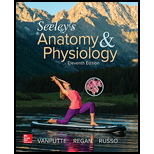
Seeley's Anatomy & Physiology
11th Edition
ISBN: 9780077736224
Author: Cinnamon VanPutte, Jennifer Regan, Andrew F. Russo Dr., Rod R. Seeley Dr.
Publisher: McGraw-Hill Education
expand_more
expand_more
format_list_bulleted
Concept explainers
Textbook Question
Chapter 19.4, Problem 12AYP
What types of formed elements develop from each of the following cells: proerythroblasts, myeloblasts,lymphoblasts, monoblasts, and megakaryocytes?
Expert Solution & Answer
Want to see the full answer?
Check out a sample textbook solution
Students have asked these similar questions
Briefly state the physical meaning of the electrocapillary equation (Lippman equation).
Explain in a small summary how:
What genetic information can be obtained from a Punnet square? What genetic information cannot be determined from a Punnet square?
Why might a Punnet Square be beneficial to understanding genetics/inheritance?
In a small summary write down:
Chapter 19 Solutions
Seeley's Anatomy & Physiology
Ch. 19.1 - List the ways that blood helps maintain...Ch. 19.1 - Prob. 2AYPCh. 19.1 - What is the normal pH range of the blood?Ch. 19.1 - Prob. 4AYPCh. 19.2 - Prob. 5AYPCh. 19.2 - Prob. 6AYPCh. 19.3 - Prob. 7AYPCh. 19.3 - Prob. 8AYPCh. 19.3 - Explain how plasma volume remains relatively...Ch. 19.4 - Name the three general types of formed elements in...
Ch. 19.4 - Prob. 11AYPCh. 19.4 - What types of formed elements develop from each of...Ch. 19.4 - Prob. 13AYPCh. 19.4 - Prob. 14AYPCh. 19.4 - Prob. 15AYPCh. 19.4 - Prob. 16AYPCh. 19.4 - Prob. 17AYPCh. 19.4 - Prob. 18AYPCh. 19.4 - Prob. 19AYPCh. 19.4 - Prob. 20AYPCh. 19.4 - Prob. 21AYPCh. 19.4 - Prob. 22AYPCh. 19.4 - Describe the morphology of the five types of white...Ch. 19.4 - Prob. 24AYPCh. 19.4 - Prob. 25AYPCh. 19.4 - Prob. 26AYPCh. 19.4 - Prob. 27AYPCh. 19.4 - What is a platelet? How do platelets form?Ch. 19.4 - Prob. 29AYPCh. 19.5 - Prob. 30AYPCh. 19.5 - What is the function of a platelet plug? Describe...Ch. 19.5 - Prob. 32AYPCh. 19.5 - Prob. 33AYPCh. 19.5 - Prob. 34AYPCh. 19.5 - Prob. 35AYPCh. 19.5 - Prob. 36AYPCh. 19.5 - Prob. 37AYPCh. 19.5 - Prob. 38AYPCh. 19.6 - Prob. 39AYPCh. 19.6 - Prob. 40AYPCh. 19.6 - Prob. 41AYPCh. 19.6 - Prob. 42AYPCh. 19.6 - Prob. 43AYPCh. 19.6 - Prob. 44AYPCh. 19.7 - What occurs in a type and crossmatch?Ch. 19.7 - Prob. 46AYPCh. 19.7 - Prob. 47AYPCh. 19.7 - Prob. 48AYPCh. 19 - Prob. 1RACCh. 19 - Prob. 2RACCh. 19 - Prob. 3RACCh. 19 - Prob. 4RACCh. 19 - Prob. 5RACCh. 19 - Prob. 6RACCh. 19 - Prob. 7RACCh. 19 - Prob. 8RACCh. 19 - Prob. 9RACCh. 19 - Prob. 10RACCh. 19 - Prob. 11RACCh. 19 - Prob. 12RACCh. 19 - Prob. 13RACCh. 19 - Prob. 14RACCh. 19 - Prob. 15RACCh. 19 - Prob. 16RACCh. 19 - Prob. 17RACCh. 19 - Prob. 18RACCh. 19 - Prob. 19RACCh. 19 - Prob. 20RACCh. 19 - Prob. 21RACCh. 19 - Prob. 1CTCh. 19 - Prob. 2CTCh. 19 - Prob. 3CTCh. 19 - Prob. 4CTCh. 19 - Prob. 5CTCh. 19 - Prob. 6CTCh. 19 - Prob. 7CT
Knowledge Booster
Learn more about
Need a deep-dive on the concept behind this application? Look no further. Learn more about this topic, biology and related others by exploring similar questions and additional content below.Similar questions
- Not part of a graded assignment, from a past midtermarrow_forwardNoggin mutation: The mouse, one of the phenotypic consequences of Noggin mutationis mispatterning of the spinal cord, in the posterior region of the mouse embryo, suchthat in the hindlimb region the more ventral fates are lost, and the dorsal Pax3 domain isexpanded. (this experiment is not in the lectures).a. Hypothesis for why: What would be your hypothesis for why the ventral fatesare lost and dorsal fates expanded? Include in your answer the words notochord,BMP, SHH and either (or both of) surface ectoderm or lateral plate mesodermarrow_forwardNot part of a graded assignment, from a past midtermarrow_forward
- Explain in a flowcharts organazing the words down below: genetics Chromosomes Inheritance DNA & Genes Mutations Proteinsarrow_forwardplease helparrow_forwardWhat does the heavy dark line along collecting duct tell us about water reabsorption in this individual at this time? What does the heavy dark line along collecting duct tell us about ADH secretion in this individual at this time?arrow_forward
arrow_back_ios
SEE MORE QUESTIONS
arrow_forward_ios
Recommended textbooks for you
 Human Biology (MindTap Course List)BiologyISBN:9781305112100Author:Cecie Starr, Beverly McMillanPublisher:Cengage LearningSurgical Tech For Surgical Tech Pos CareHealth & NutritionISBN:9781337648868Author:AssociationPublisher:Cengage
Human Biology (MindTap Course List)BiologyISBN:9781305112100Author:Cecie Starr, Beverly McMillanPublisher:Cengage LearningSurgical Tech For Surgical Tech Pos CareHealth & NutritionISBN:9781337648868Author:AssociationPublisher:Cengage Principles Of Radiographic Imaging: An Art And A ...Health & NutritionISBN:9781337711067Author:Richard R. Carlton, Arlene M. Adler, Vesna BalacPublisher:Cengage Learning
Principles Of Radiographic Imaging: An Art And A ...Health & NutritionISBN:9781337711067Author:Richard R. Carlton, Arlene M. Adler, Vesna BalacPublisher:Cengage Learning Biology (MindTap Course List)BiologyISBN:9781337392938Author:Eldra Solomon, Charles Martin, Diana W. Martin, Linda R. BergPublisher:Cengage Learning
Biology (MindTap Course List)BiologyISBN:9781337392938Author:Eldra Solomon, Charles Martin, Diana W. Martin, Linda R. BergPublisher:Cengage Learning


Human Biology (MindTap Course List)
Biology
ISBN:9781305112100
Author:Cecie Starr, Beverly McMillan
Publisher:Cengage Learning

Surgical Tech For Surgical Tech Pos Care
Health & Nutrition
ISBN:9781337648868
Author:Association
Publisher:Cengage

Principles Of Radiographic Imaging: An Art And A ...
Health & Nutrition
ISBN:9781337711067
Author:Richard R. Carlton, Arlene M. Adler, Vesna Balac
Publisher:Cengage Learning

Biology (MindTap Course List)
Biology
ISBN:9781337392938
Author:Eldra Solomon, Charles Martin, Diana W. Martin, Linda R. Berg
Publisher:Cengage Learning

Types of Human Body Tissue; Author: MooMooMath and Science;https://www.youtube.com/watch?v=O0ZvbPak4ck;License: Standard YouTube License, CC-BY